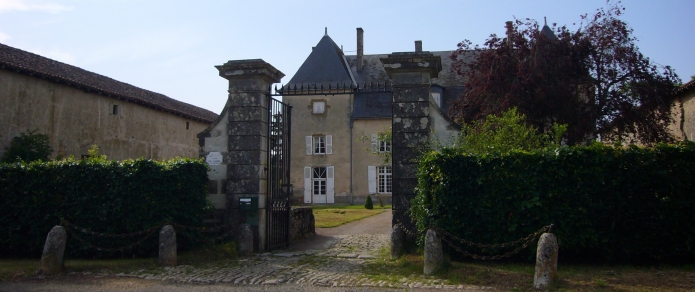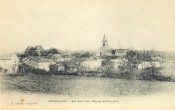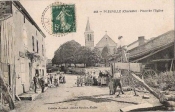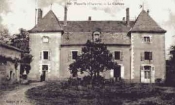Pleuville & District

Château de Pleuville, along with all the other significant buildings and topographical features of north-eastern Charente, was the subject of a remarkable local study, L’inventaire de la Communauté de communes du Confolentais (2007). This page relates to the chateau. From here one can navigate to the rest of the survey, all of which is well illustrated.
Pleuville in a nutshell
- The name Pleuville is thought to derive from Pleone villa, a property belonging to someone named Pleon during the Roman occupation.
- About 390 people now live full-time in the commune of Pleuville, which includes the village and several settlements roundabout. 5 per cent are UK expatriates.
- The main occupation is agriculture, but the area used to be well-known for its brick and tile works, now all closed. A fast-expanding company STPR, which carries out major sewerage and other mechanical digging work in the region,was founded here about 25 years ago and now occupies a large site on the outskirts. Possibly for this reason Pleuville was one of the first rural communes in the area to install mains drainage.
- Local children still attended Pleuville school until summer 2013, but by then numbers were judged to be too small, and Pleuville children are now bussed to Charroux or Pressac. The school building is still in use for community activities. The church of St Pierre, though not without interest, is an 1860s rebuild. As a result of demographic changes and the availability of supermarkets all the shops which used to trade in Pleuville village have shut down. The last was a hairdresser which closed in 2007. The bar Le Central opened a general shop some years ago which is well patronised.
- Pleuville has its own sports ground with grandstand, community hall, and public camp site. All these are grouped together on land which used to belong to the chateau.
- Apart from Château de Pleuville there are two other large chateaux in the commune. Château de Gorce to the south of the village is now listed in the French national inventory of historic buildings. Parts of it date from the 15th century, and it has recently been sensitively restored. It was the main local seat of power, and the principal residence of the Verrier de Boulzat family from the 17th century. The current owners offer holiday accommodation of very high quality. On the northern border of the commune is Château de La Grollière, a tasteful example of 19th-century romantic architecture, used as German officers’ quarters during World War II. It has also received recent restoration and is easily admired from the public road. These and all the other numerous chateaux in the Confolentais are covered in detail in the 2007 Inventaire mentioned above, which is accessible in full on line.
Pleuville: border village
Pleuville lies on or very near several boundaries. For example:
Languages
Before the 19th century most inhabitants of France spoke local languages rather than “French”. These were divided into two main groups – the langue d’oïl group generally to the north and west, and the langue d’oc or occitane group generally to the south and east. The rough dividing line between the two groups in the south west runs through Pleuville. Here as in most areas of France, local words and expressions from the older languages are still in everyday use, and several authors still write in them, notably Jean-Francois Migaud who uses the local variant of Poitevin-saintongeais (the regional version of the langue d’oïl). Migaud was born in Pleuville. By contrast Jean-Louis Queriaud recently published a major study of oral literature based on research in villages just to the east of Confolens (about 16 km south east of Pleuville). The language there was/is Limousin, the regional version of occitane.
Administration
An early outcome of the French Revolution was the creation of new administrative areas called Départements in 1790. For most of the time since then Pleuville has been right on the border of the Département of the Charente. Pleuville commune is surrounded on three sides by communes in Vienne; its northern boundary coincides with that of the departement. Although for administration Pleuville is in the Confolens nord area of the Charente based on the town of Confolens, the nearest town to Pleuville is actually Charroux which is in Vienne.
The Line of Demarcation
Following the armistice with Germany in June 1940, France was divided into two large administrative areas. The northern half and a strip from the Atlantic coast extending about 150 km inland (the “occupied zone”), were to be administered directly by the Germans based in Paris, while the remaining southern area (the “free zone”) was placed under a French government set up at Vichy. The notorious Line of Demarcation between the zones ran from the Swiss border across to a point south of Tours, then turned south to meet the border with Spain. Tours, Poitiers, Angoulême and all the cities and ports on the Atlantic coast thus remained in the occupied zone. The line crossed the boundary between the Charente and Vienne departments at the northern end of Pleuville commune near Château de la Grollière, and continued south to skirt the village centre on its west side. The commune was split in two, and while the village itself was left in the free zone, the nearest settlement to the west, La Courcelle, found itself in the occupied zone. As on all roads which crossed the line, a roadblock with checkpoint manned by soldiers and customs men (both French and German) was set up on the road from Charroux, just outside Pleuville cemetery. On the same spot in November 2012, nearly 70 years after the war ended, an information board was erected, reflecting a continued desire locally to remember the line of demarcation and its unwanted impact.
The Pleuville area
Pleuville is set in limestone country criss-crossed by the upper reaches of the river Charente and its tributaries. There are many beautiful small valleys, especially to the south and west of Pleuville. (For a good example take the 4 km road from Pleuville to Chatain, which offers lovely views over the valley of the Charente before descending to cross an excellent medieval bridge.) The area is regarded as underpopulated but is tidily maintained despite its lack of prosperity. Its remoteness has attracted incomers, including some from the UK, to replace the retreating younger French, but has also helped to preserve a remarkable number of local rural buildings, so that much remains as it was in the 19th century.
Although rather out-of-date now, here is the most informative general website concerning Pleuville.



